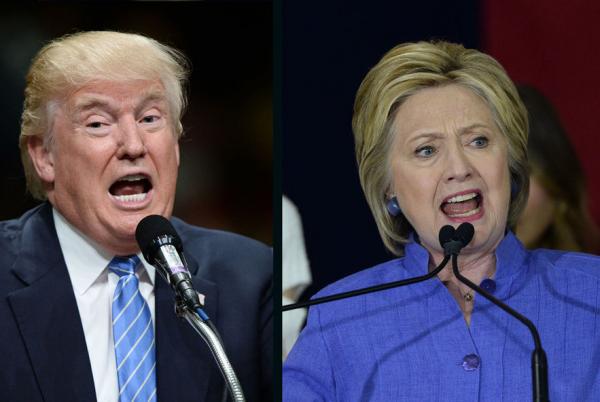WASHINGTON, Oct. 13 (UPI) — There may be no single issue where presidential candidates Hillary Clinton and Donald Trump are farther apart than on taxes.
The Wall Street Journal reported the difference between the two tax plans put forth is a whopping $6 trillion. That’s trillion, with a “T.”
The plans put forth by the two candidates are largely in line with party orthodoxy. Democrats favor lowering taxes on middle-class Americans and raising them on large corporations and the wealthy — though Clinton favors cuts for small businesses. Republicans favor lower taxes across the board and in particular tax cuts for businesses and the wealthiest Americans — though Trump has proposed some tax cuts he said will help low-income families the most.
And in a rare moment of agreement, both candidates favor tax penalties for corporations that move jobs out of the country.
Here’s a look at the highlights of their proposals.
Under Clinton, rich would pay more
Hillary Clinton’s plan begins with what she calls the “Fair Tax Surcharge” — a 4 percent tax for all Americans who earn more than $5 million per year. Clinton’s explanation for the surcharge is wealthy Americans frequently structure investments and income in the most advantageous way for their tax bills, a benefit that is not afforded to low- and middle-income earners who have federal taxes deducted from their paychecks and typically file uncomplicated returns, with few ways to reduce their tax liability. Her campaign estimates the surcharge would only apply to the top 0.02 percent of taxpayers.
Clinton also favors closing a number of tax loopholes frequently used by wealthy Americans and enacting the “Buffett Rule,” named after billionaire investor Warren Buffett, who famously protested the fact that, after utilizing all the loopholes available to him, his effective tax rate as a percentage of his income was less than his secretary who makes $50,000 per year. The Buffett Rule mandates that no wealthy American should pay an effective tax rate of less than 30 percent.
Clinton has also proposed expanding the estate tax for the wealthiest taxpayers. At present, estates worth more than $5 million are taxed at 40 percent. She would add three brackets on top of that. Estates worth $10 million would be taxed at 50 percent; estates worth $50 million would be taxed at 50 percent; estates worth $500 million or more would be taxed at 65 percent.
Another loophole on Clinton’s chopping bloc involved tax-preferred retirement savings accounts, which some wealthy individuals use to shelter millions from tax liability. Clinton has proposed limiting the amount an individual can save in a retirement account.
She also favors increasing the length of time investors must hold onto stocks before they qualify for the lower tax rate on capital gains, which the government enacted in a bid to spur investment in the stock market.
As for the bottom 95 percent of earners, Clinton proposes leaving the present tax code mostly in tact. Her most significant proposal for low- and middle-income earners would be an expanded benefit that all parents would receive, including the roughly 50 percent of Americans who do not earn enough money to qualify to pay income taxes at all. Clinton said Tuesday she would double the child tax credit to $2,000 and create an equivalent cash benefit for parents who have little or no income.
On corporate taxes, Clinton favors ending the so-called “inversion loophole” that allows U.S. companies to merge with foreign competitors and move their assets overseas to a more favorable corporate tax environment. She also favors implementing an “exit tax” on companies that move business out of the country.
She has also called for streamlining tax laws for small businesses, noting the smallest firms, those employing one to five people, typically spend 150 hours a year to remain in compliance with federal tax law.
Clinton has proposed using the new revenue raised in her plan to fund much of her domestic agenda, including substantial investments in infrastructure spending, paid maternity and paternity leave for all new parents and more spending on education.
The bottom line: Clinton’s tax plan would raise taxes on the wealthy and corporations to the tune of $1.1 trillion over 10 years, according to the nonpartisan Tax Policy Center.
Trump would build on the GOP’s existing tax blueprint
Donald Trump’s tax plan is largely rooted in the blueprint put forth by Republicans in Congress, with additional tax credits for the poor.
Trump’s income tax plan calls for consolidating the number of income brackets to three:
— Joint filers making less than $75,000 would pay 12 percent.
— Joint filers making $75,000 to $225,000 would pay 25 percent.
— Joint filers making more than $225,000 would pay 33 percent.
Tax rates for single filers would be half the income total as joint filers.
Trump also proposes overhauling income tax deductions. He would increase the standard deduction to $30,000 for joint filers and $15,000 for single filers. He would also repeal the 3.8 percent “investment tax” that helps fund the Affordable Care Act. He would cap standard deductions at $200,000 for joint filers and $100,000 for single filers.
While Clinton wants to significantly expand the estate tax, Trump’s plan calls for its blanket repeal, allowing individuals to pass the full value of their estates onto beneficiaries.
Trump has proposed allowing all parents to deduct the full cost of childcare from their income taxes, capped at the average cost of childcare in their state. Another deduction would apply to adults caring for an elderly parent, capped at $5,000 per year, increasing annually, tied to the inflation rate.
For individuals who do not make enough money to qualify for paying income tax, Trump’s plan calls for a rebate for the cost of childcare through an expansion of the Earned Income Tax Credit. Single parents making less than $31,200 and couples making less than $62,400 would qualify for the rebate.
On the business side, Trump has proposed reducing the corporate tax rate from 35 percent to 15 percent, while closing tax loopholes that allow some large companies to pay far less than the present 35 percent. Companies would only be allowed to claim tax deductions for expenses related to research and development.
Trump’s plan would also allow small business owners to pay the 15 percent rate instead of claiming their profits as personal income, provided the funds remain invested in the company.







